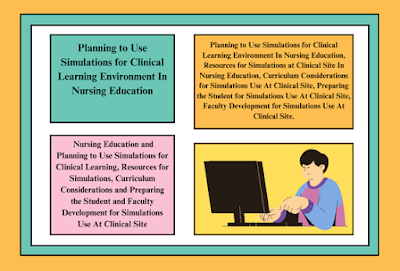The Planning to Use Simulations for Clinical Learning Resources for Simulations Curriculum Considerations and Preparing the Student and Faculty Development for Simulations Use At Clinical Site In Nursing Education. Simulation helps develop different scenarios that require both clinical skills and critical thinking skills from nurses to solve problems.
The Planning to Use Simulations for Clinical Learning Resources for Simulations Curriculum Considerations and Preparing the Student and Faculty Development for Simulations Use At Clinical Site In Nursing Education
Nursing simulation labs replicate a clinical environment and allow nursing students to safely practice nursing scenarios and hone their skills before applying them in clinical and practical exercises with real patients.
Medical simulation allows for the acquisition of clinical skills through specific practices rather than apprenticeship-like learning. Simulation tools serve as an alternative to real patients. Medical trainees can make mistakes and learn from them without fear of harming the patient.
Simulation-based training is proving to be an effective educational strategy for acquiring and maintaining clinical skills in medical education. Evidence suggests its superiority over no intervention and, in some cases, over traditional training methods.
Development for Simulations Use At Clinical Site
1. Strategic Planning for Simulations
Effective use of simulations in nursing education requires thorough planning. Key considerations include:
- Resource Allocation: Identify the necessary resources, including physical space, equipment, and technology.
- Curriculum Integration: Align simulations with the overall curriculum and course objectives.
- Student Preparation: Ensure students are adequately prepared for simulation-based learning.
- Faculty Development: Train faculty to effectively use and facilitate simulations.
Resources for Simulations at Clinical Sites
1. Physical Space and Equipment
Operationalizing simulations requires:
- Adequate Space: Ensure there is sufficient room for teaching, learning, faculty offices, equipment storage, debriefing, and video recording if needed.
- Simulation Equipment: Utilize a variety of equipment and technology, such as manikins, virtual reality, electronic health records, and audiovisual tools.
2. Support Staff
- Technical Support: Employ staff to manage and maintain simulation equipment and technology.
- Simulation Facilities: Well-resourced spaces should replicate real clinical settings, like acute care environments or operating room suites.
Curriculum Considerations for Simulations
1. Needs Assessment and Analysis
- Curriculum Alignment: Conduct a needs assessment to understand how simulations fit into the broader curriculum and intersect with clinical site placements.
- Competency and Standards: Integrate QSEN competencies, national patient safety goals, the NCSBN Licensure Examination blueprint, and Institute of Medicine initiatives into simulation design.
2. Schematic Design
- Course Objectives: Develop a schematic design for each course, ensuring that simulation aligns with theoretical knowledge, clinical practice, and learning goals.
Preparing Students for Simulations
1. Student Orientation
- Equipment Familiarization: Orient students to simulation equipment and their roles as active learners.
- Learning Goals: Clearly outline the learning objectives, required assignments, and the relevance of simulations to clinical practice.
- Assessment Expectations: If simulations are used for evaluation, provide clear rubrics and opportunities for students to practice with the equipment.
2. Benefits of Simulations
- Flexible Learning: Simulations offer flexible, accessible opportunities for skill practice outside traditional class hours.
- Safe Practice Environment: They provide a safe space for repeated practice and exposure to real-life clinical scenarios, enhancing confidence and competence.
Faculty Development for Simulations
1. Evolving Faculty Roles
- Facilitator Role: Shift from a traditional teacher-centered approach to a student-centered, facilitative role during simulations.
- Simulation Management: Faculty must support learners throughout simulations and facilitate debriefing sessions.
2. Training and Support
- Pretraining: Provide pretraining on simulation pedagogy and debriefing techniques to ensure faculty are comfortable and competent.
- Orientation Courses: Develop or participate in orientation courses to learn about simulation design, technology use, and debriefing methods.
- Continuous Support: Offer ongoing support to faculty, including assistance with simulation design and equipment setup.
3. Addressing Challenges
- Novice Faculty Support: Assist new faculty in operationalizing critical thinking objectives through structured guidance and questions (Whei Ming & Juestel, 2010).
- Experience Sharing: Encourage faculty to experience simulations firsthand through orientation courses to better understand the process and their role.
Planning to Use Simulations for Clinical Learning Resources for Simulations Curriculum Considerations and Preparing the Student and Faculty Development for Simulations Use At Clinical Site In Nursing Education
Planning to Use Simulations for Clinical Learning Resources for Simulations Curriculum Considerations and Preparing the Student and Faculty Development for Simulations Use At Clinical Site In Nursing Education
Planning to Use Simulations for Clinical Learning Resources for Simulations Curriculum Considerations and Preparing the Student and Faculty Development for Simulations Use At Clinical Site In Nursing Education
Read More:
https://nurseseducator.com/didactic-and-dialectic-teaching-rationale-for-team-based-learning/
https://nurseseducator.com/high-fidelity-simulation-use-in-nursing-education/
First NCLEX Exam Center In Pakistan From Lahore (Mall of Lahore) to the Global Nursing
Categories of Journals: W, X, Y and Z Category Journal In Nursing Education
AI in Healthcare Content Creation: A Double-Edged Sword and Scary
Social Links:
https://www.facebook.com/nurseseducator/
https://www.instagram.com/nurseseducator/
https://www.pinterest.com/NursesEducator/
https://www.linkedin.com/in/nurseseducator/
https://www.researchgate.net/profile/Afza-Lal-Din
https://scholar.google.com/citations?hl=en&user=F0XY9vQAAAAJ
